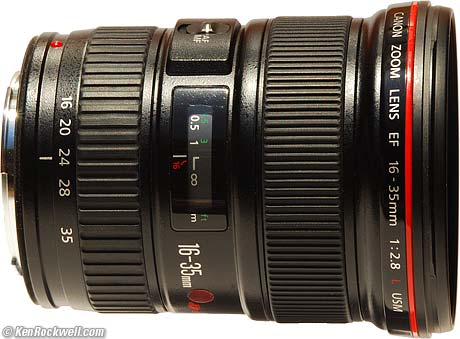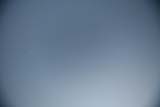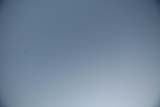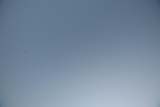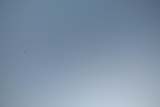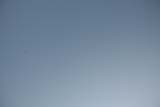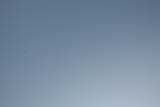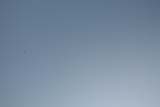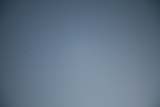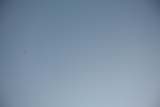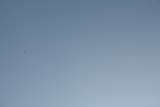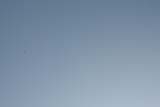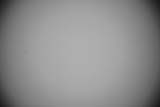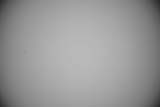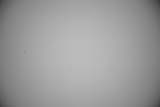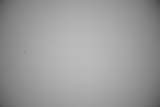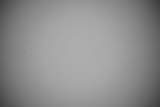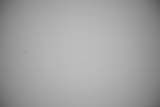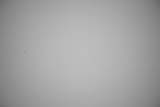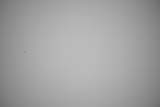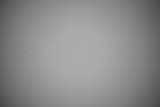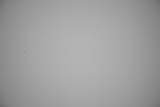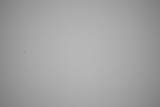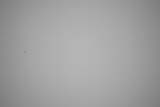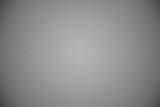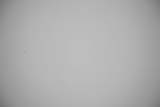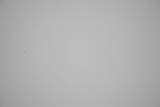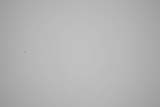FILTERS
Back to Performance. Back to Introduction. Back to Top.
The 16-35mm f/2.8 L works great with any conventional filter, even on full-frame cameras. There is no need to pay extra for thin filters. This includes my conventional Hoya 77mm Circular Polarizer and my Tiffen 0.6 ND grad, both of which are in thick (7mm) rotating mounts.
I love filters, and often use two or three on top of each other.
Even on my full-frame 5D I could use two of these fat rotating mount filters (13.7mm thick excluding threads) as wide as 20mm.
There are even fewer issues on smaller sensor cameras. Here's an image of the sky made at 16mm on my full-frame 5D with two filters stacked. The red outline shows what would be seen by a 1.3x camera camera like the 1D Mk II N and the green shows the image used by a 1.6x crop factor camera like a 30D.

At 16mm with two stacked filters.
The dark band is the natural polarization of the sky as seen at this ultra-wide angle through my polarize and old style, 7mm thick Tiffen ND 0.9. These two filters together were 13.7mm thick, excluding threads.
You easily can use two conventional, fat rotating filters on this lens at any focal length with anything other than a full-frame camera.
FLARE AND GHOSTS
Back to Performance. Back to Introduction. Back to Top.
Ghosts have always been a problem with wide lenses. This is because the wide angle often includes the sun, and all the many elements in these lenses will cause ghosts unless the designers pay careful attention. Newer lenses are better at this.
The 16-35mm F/2.8 L is a little worse than the Canon 17-40mm f/4 L. The 10-22mm EF-S is much better than either of these, and shows no flare in these same tests.
Forget the ghosts, look at the great color I got shooting into the sun! These are exactly as they came from my 5D except for resizing.
Here's what you get at f/4 at 16mm, no filter. I saw no degradation using a single-coated filter.
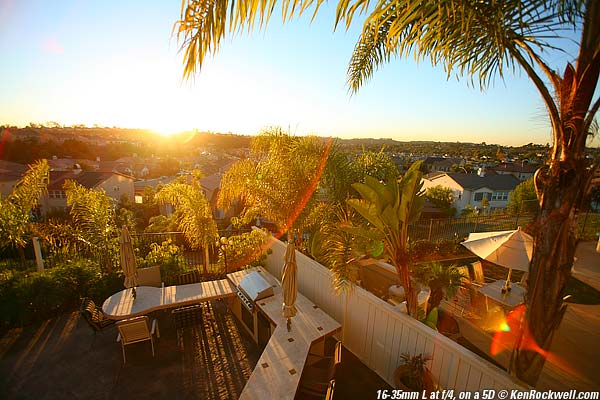
Flare at 16mm at f/4, no filter. Roll mouse over to compare with 17-40mm f/4 L.

Flare at 16mm at f11, no filter. Roll mouse over to compare with 17-40mm f/4 L.
Look in the sky and you'll see retrograde ghosts above the sun, too! TheCanon 17-40mm f/4 L is better than the 16-35mm L for ghosts.
Color rendition of these two lenses is the same. The 16-35mm L looks warmer here because of all the orangish flare running around.
USE with FLASH
Back to Performance. Back to Introduction. Back to Top.
Built-in flashes are often so close to the camera that ultrawide lenses can see far enough down to see their shadow cast by a built-in flash.
Using this lens on a 1.6x camera is a waste of a great lens, but if you do, you'll get a shadow at 18mm and wider. It's fine at 20mm and longer.
If you get close, stay at 24mm or longer if you're only a foot or two away.
If this becomes a problem, hold the camera upside down so the shadow goes into the top of the picture where it's less likely to be a problem.
Shoe-mount flashes are far enough forward that the shadows aren't seen by wide lenses.
MACRO
Back to Performance. Back to Introduction. Back to Top.
Ultra wide lenses are silly to use for macro shots.
The Canon 16-35mm f/2.8 L is an especially poor choice because I consistently got focus errors at its closest focus distance at 35mm. The Canon 17-40mm f/4 L isn't as bad, but still has some of the same effect. If you want macro, the inexpensive 100mm f/2.8 USM is a better choice.
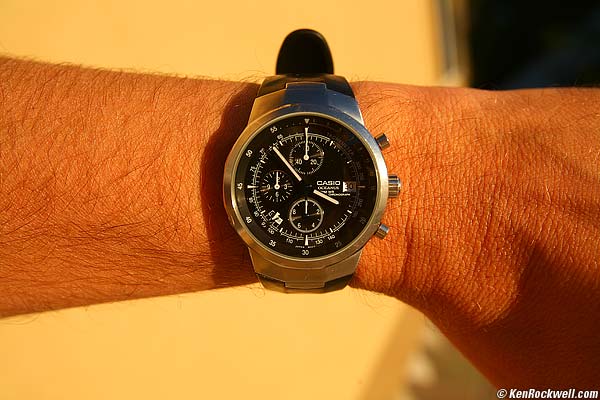
at closest focus at 35mm and 1 foot, full-frame image.
As an ultrawide it doesn't get as close as the $100 18-55mm EF-S included with the less expensive bodies.
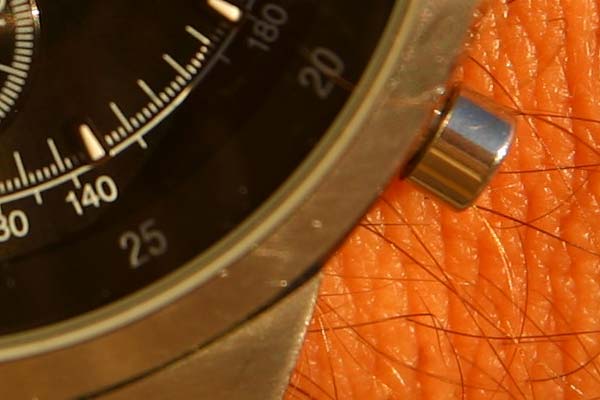
100% crop from above, no extra sharpening.
I got this focus offset consistently: it focused beyond my watch on my arm. The correct AF sensor was selected and I got the same results many times with other different subjects. I tried the 17-40mm f/4 L, and it was perfect, just like the cheap 18-55mm EF-S is on other cameras.
Avoid wides for macro, and especially avoid this one. This is at f/7.1 at 1/200 at ISO 50. It 's much worse wide open, and even at f/16 the depth of field is still so narrow that the consistent focus error is visible at 100%.
I didn't try this on a 1.6x camera.
For macro, do yourself a favor and get the spectacular and inexpensive 100mm f/2.8 USM.
SERIAL NUMBER
Back to Performance. Back to Introduction. Back to Top.
The serial number is engraved and filled with black paint on the lens mounting flange. It's on the bottom side as you point the lens away from you with the top up. It's engraved in the recess of the surface that mates with the camera, which will make it difficult for the forces of evil to remove without destroying the lens.
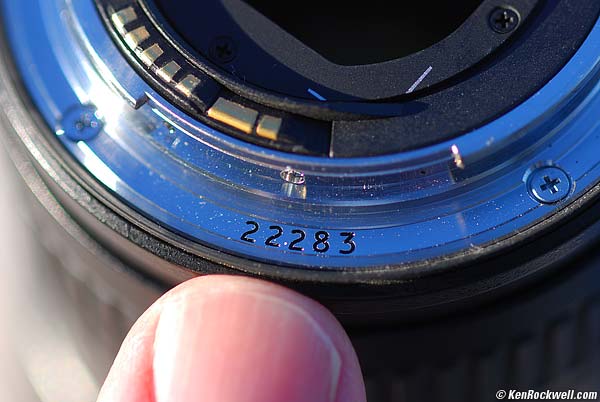
Engraved and painted serial number location, Canon 16-35mm f/2.8 L.
SHARPNESS
Back to Performance. Back to Introduction. Back to Top.
So long as you stop down to f/4, get everything in proper focus and don't linger in the corners at the wide end, your technique will be your biggest barrier to sharp photos. I have a page on How to Get Sharp Photos.
At f/4 and smaller it's incredibly sharp away from the sides and corners (full-frame). The shots I made are incredible. Here's a shot at 16mm at f/11:
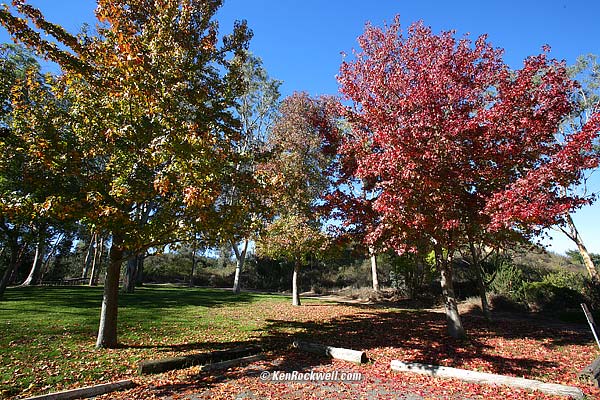
16-35mm f/2.8 L at 16mm and f/11 on a 5D. Click for 6MB original.
and here's a 100% crop of the top left corner from my 5D:
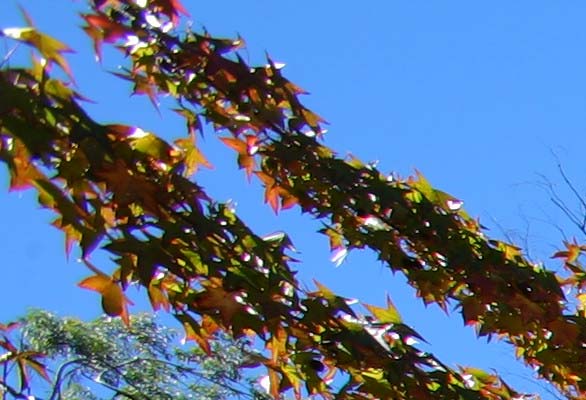
100% corner crop, 5D, 16-35mm f/2.8 L at 16mm and f/11. Click for 6MB original.
If you enjoy looking for an obvious imperfection, it's very, very soft in the corners (full-frame) at 16mm wide open. It gets better as you stop down, and is sharp by f/11 as you see above.
My Nikon 17-35mm AF-S also gets soft in the corners at 17mm wide open, as I saw when I mounted it on my 5D to try it. This has nothing to do with digital sensors or any other baloney. Super wide retrofocus lenses get soft in the corners. They've been doing this since they were invented in the 1950s and are the reason some of us still shoot view cameras. I have this same shot on film with a modern Made-in-Germany Schneider 47mm Super Angulon XL which I'll be scanning and sharing later.
The 16-35mm L is supposed to be soft in the corners at 16mm wide open. It's designed that way. Not that we want it that way, but that's the way it is and the way it's specified by Canon. See Canon's MTF curves printed in Canon EF Lens Work III, page 223, and I'm sure online as well. Canon would love to sell us a better lens, but to get this perfectly sharp in the corners at f/2.8 and 16mm would require a 30-pound lens that costs $25,000. Since no one would buy that lens, this is as good as it gets for a 1.5 pound lens that sells for $1,500.
The 16-35 L's MTF curves all plummet to zero at r = 21.6mm, which is a scientific way of saying that it's hideously soft in the corners at 16mm at f/2.8 on a full-frame camera.
On a 1.6x camera the corners are as sharp as the center.
The corners on a 1.3x camera are the same as the sides of a full-frame camera and have no problem.
Here's the problem: here's what that corner looks like at f/8 at 16mm on a full-frame camera:
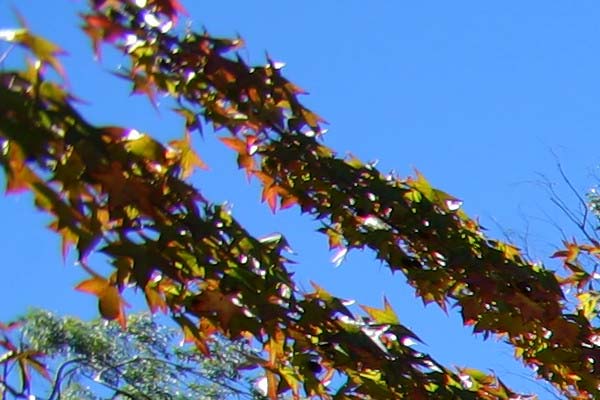
100% corner crop, 5D, 16-35mm f/2.8 L at 16mm and f/8.
Open up to f/5.6 and we have:
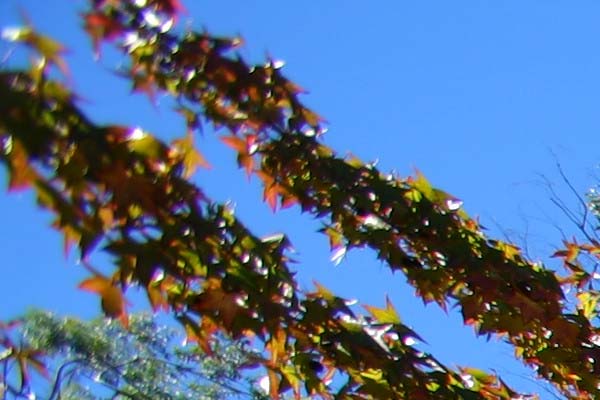
100% corner crop, 5D, 16-35mm f/2.8 L at 16mm and f/5.6.
At f/4 we get:
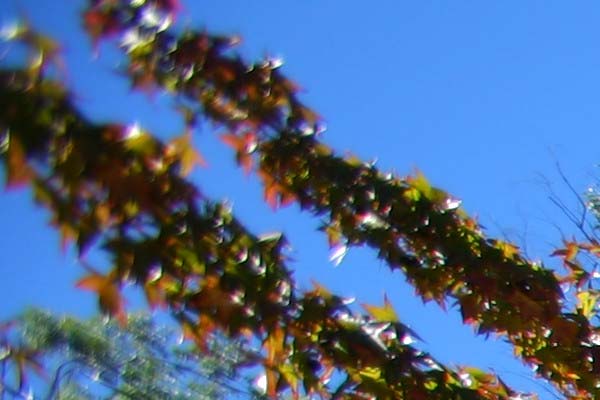
100% corner crop, 5D, 16-35mm f/2.8 L at 16mm and f/4.
And wide open at f/2.8 we get:
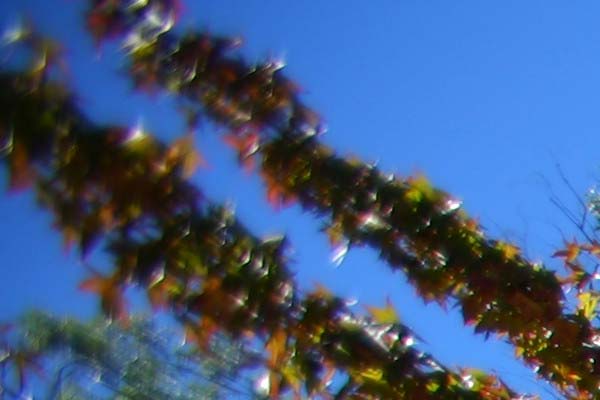
100% corner crop, 5D, 16-35mm f/2.8 L at 16mm and f/2.8.
This looks hideous if you do what I did first and look at it at 100%, but let's look at it again at f/2.8 and 16mm full-frame and see that it's not that big a deal:
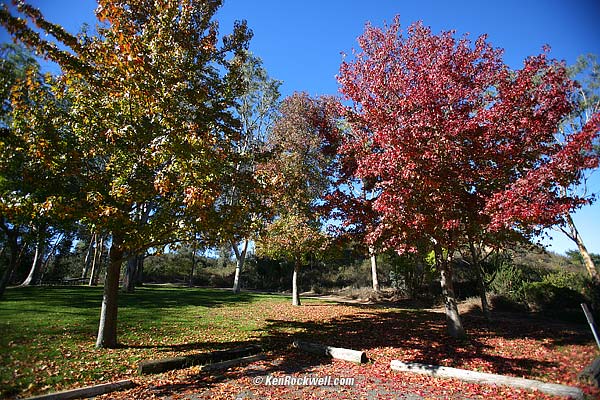
16-35mm f/2.8 L at 16mm and f/2.8 on a 5D.
You can see obvious light falloff, but so what, it adds to the image and you shouldn't be shooting at f/2.8 in daylight anyway. Yes, the corners are soft at 16mm and f/2.8. I had to go out of my way to create an image that didn't have sky in both top corners and out-of-focus foreground in the lower ones.
Due to occasionally inconsistent autofocus, it's not unusual to see variation between successive shots. I sometimes saw weird regions of unsharpness even if other regions were OK. I've seen this before in my Nikon 17-35mm f/2.8 AF-S. It comes from the mechanical realities of cams and ultra wideangle zoom lenses. Ultrawide lenses have vanishingly low tolerance for mechanical errors as you focus and zoom, so every shot doesn't always come out perfect. If you need perfect every time, use a view camera, or don't go looking at every shot at 100%.
Diffraction is usually the sharpness-limiting factor for all lenses, especially digital SLRs, at about f/11 and above. See also How Sharpness Varies with Aperture.
These are subjective. Don't fret over differences between adjacent grades.
Sharpness Ratings
Full Frame: (Center - far sides - very far corner)
These are tested on my 5D.
Letters correspond to center - side - far corner on full-frame. I'm looking at the farthest ends of each corner. The performance of the 16-35mm dies in the last millimeter or so, so if you ignore the last millimeter, which usually has nothing in it anyway, the corner grades would improve immensely.
All corners were about the same, showing solid manufacturing and quality control.
|
f/2.8 |
f/4 |
f/5.6 |
f/8 |
f/11 |
16 mm |
G - F - P |
E - VG - P |
E - E - P |
E - E - P |
E - E - VG |
20 mm |
VG - G - P |
E - G - P |
E - G - P |
E - E - P |
E - E - VG |
24 mm |
VG - G - F |
E - G - F |
E - E - G |
E - E - G |
E - E - E |
35 mm |
G - G - F |
E - VG - G |
E - E - VG |
E - E - VG |
E - E - E |
1.3x (1D, 1D Mk II, 1D Mk II N): (Center - far corner)
|
f/2.8 |
f/4 |
f/5.6 |
f/8 |
f/11 |
16 mm |
G - F |
E - VG |
E - E |
E - E |
E - E |
20 mm |
VG - G |
E - G |
E - G |
E - E |
E - E |
24 mm |
VG - G |
E - G |
E - E |
E - E |
E - E |
35 mm |
G - G |
E - VG |
E - E |
E - E |
E - E |
1.6x (30D, 20D, Rebels): (Center, far corner)
As tested on my Rebel XTi. The XTi has very high linear resolution and is very sensitive to the focus inconsistencies I see with this lens. You may have to try a couple of times at the larger apertures.
|
f/2.8 |
f/4 |
f/5.6 |
f/8 |
f/11 |
16 mm |
G - F |
VG - VG |
E - VG |
E - E |
E - E |
20 mm |
VG - G |
E - G |
E - G |
E - E |
E - E |
24 mm |
VG - F |
E - E |
E - E |
E - E |
E - E |
35 mm |
G - G |
E - E |
E - E |
E - E |
E - E |
IS (Image Stabilization)
Back to Performance. Back to Introduction. Back to Top.
The 16-35mm f/2.8 L has NO image stabilization. It's so wide that this isn't a problem, you can hand-hold it much slower than a normal lens.
TIP: In dim light, fire several shots and pick the sharpest. It's a random event, so if you fire enough shots, you'll eventually get a sharp one even ar speeds of 1 second!
ZOOMING
Back to Performance. Back to Introduction. Back to Top.
Easy one-finger-tip control.
Focal Length EXIF Encoding
Encoding is perfect at 16, 20, 24, 28 and 35mm as marked. This is better than most lenses that are usually off a millimeter or so.
Focal Lengths Encoded
Here are the focal lengths I've seen in my EXIF data:
16mm, 17mm, 18mm, 19mm, 20mm, 21mm, 22mm, 23mm, 24mm, 25mm, 26mm, 27mm, 28mm, 30m, 31mmm, and 35mm.
I suspect 32mm, 33mm and 34mm would appear, I just didn't see them.
Compared top
Introduction Specs Performance Compared Recommendations
See Canon Ultrawide Zooms Compared.
RECOMMENDATIONS top
Introduction Specs Performance Compared Recommendations
This is your lens if you need the absolute widest zoom available from a top-drawer manufacturer for a full-frame camera. I've never liked the mechanical quality of the Sigma lenses, even though their on-paper specs and prices intrigue the innocent.
This is your lens if you need f/2.8 in a super-wide full-frame zoom.
If you can live with only 17mm and only f/4 then the Canon 17-40mm f/4 L is a better choice. I just ordered a 17-40mm for myself after living with both of them for the month of November 2005, if that helps you decide.
The 17-40mm at f/4 is better than the 16-35mm at f/2.8. All the 16-35mm does at f/2.8 is get fuzzy most of the time.
I get more consistent results with a 17-40mm f/4 L, which also weighs less and costs half as much. By consistent I mean getting every shot sharp without the occasional soft one.
To its defense, the 16-35mm L I was loaned was a well-beaten loaner that arrived in a box simply wrapped in bubble wrap, after having been loaned to many others not particularly concerned about taking care of it. The 17-40mm L I've used is one loaned to me in new condition by a very careful owner.
Then again, these lenses are built to take a beating. My pal humanitarian photojournalist Karl Grobl just dropped his 1D Mk II and 70-200 f/2.8 IS L nine feet (3m) onto a cobblestone street off an elephant on which he was riding in Jaipur, Rajasthan, India, and after bending the plastic shade back into shape it all worked perfectly.
I have a review of the 17-40mm coming as soon as I can write it; I collected the same data as I tested this 16-35mm L.
This 16-35mm f/2.8 L is great when you need f/2.8 or need the widest possible 16mm angle of view, but otherwise the extra 4 ounces takes a toll on my neck. I guess I'm not cut out to be a pro photojournalist like my pal Karl, who caries his 16-35mm L on a 1D Mk II and a 70-200 f/2.8 IS L on another 1D Mk II for weeks at a time out in the boonies. See any wide photos you like on his site? They were probably made with this 16-35mm lens on his 1.3x camera.
Forget either of these lenses if you have a Rebel, 20D or 30D (1.6x sensor). Get the 10-22mm EF-S instead if you want wide, and any of the other EF-S zooms if you want a wide - tele zoom.
Help me help you top
I support my growing family through this website, as crazy as it might seem.
The biggest help is when you use any of these links to Adorama, Amazon, eBay, Ritz, Calumet, J&R and ScanCafe when you get anything, regardless of the country in which you live. It costs you nothing, and is this site's, and thus my family's, biggest source of support. These places have the best prices and service, which is why I've used them since before this website existed. I recommend them all personally.
If you find this
page as helpful as a book you might have had to buy or a workshop you may
have had to take, feel free to help me continue helping everyone.
If you've gotten your gear through one of my links or helped otherwise, you're family. It's great people like you who allow me to keep adding to this site full-time. Thanks!
If you haven't helped yet, please do, and consider helping me with a gift of $5.00.
As this page is copyrighted and formally registered, it is unlawful to make copies, especially in the form of printouts for personal use. If you wish to make a printout for personal use, you are granted one-time permission only if you PayPal me $5.00 per printout or part thereof. Thank you!
Thanks for reading!
Mr. & Mrs. Ken Rockwell, Ryan and Katie.
Home Donate New Search Gallery Reviews How-To Books Links Workshops About Contact |

